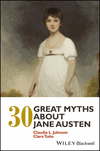AS PRIDE AND PREJUDICE SHOWS, ALL AUSTEN'S NOVELS ARE LOVE STORIES
Summary
Writing to her sister Cassandra on 4 February 1813, a week after Pride and Prejudice was published, Jane Austen admitted to “fits of disgust” at what would prove to be her most popular novel. Austen's letter suggests that she wanted her readers to acknowledge and appreciate something more – something beyond love, romance, and the happy ending. The irony in Pride and Prejudice has a particular quality. Austen's word of choice, “Epigrammatism,” invokes the subtlest form of irony, the “pointed” mode of expression, where “pointed” means indirect – playful, ironic, self-conscious, self-reflexive. There may be more to Pride and Prejudice than its love story is signaled by the novel's opening dialogue between Mr. and Mrs. Bennet, with its ironic counterpoint between realism and romance. One function of the novel's opening sentence–indeed, its opening chapter–is to develop the epigrammatic irony.



